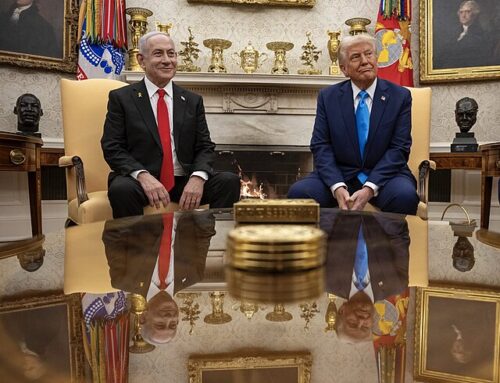 Foreign minister and Yisrael Beitenu (Israel Our Home) party leader Avigdor Lieberman (also spelled Liberman) has long advocated a transfer of parts of Israel heavily populated by Palestinian Israelis, as compensation to the Palestinians for annexing the settlement blocs, in establishing a two-state solution. This has been widely condemned as “racist” by Israel’s left, including Meretz. But speaking only for myself here, I wish to look at this proposal without condemning it outright.
Foreign minister and Yisrael Beitenu (Israel Our Home) party leader Avigdor Lieberman (also spelled Liberman) has long advocated a transfer of parts of Israel heavily populated by Palestinian Israelis, as compensation to the Palestinians for annexing the settlement blocs, in establishing a two-state solution. This has been widely condemned as “racist” by Israel’s left, including Meretz. But speaking only for myself here, I wish to look at this proposal without condemning it outright.|
Lieberman (aka Liberman)
|
I’ve looked at this issue back in 2010 (“Is Lieberman’s idea for 2 states ‘racist’?“), concluding then that:
if this were a real option considered in negotiations–an unlikely “if”–that Arab citizens of Israel in the triangle, even if they chose to remain where they are as citizens of Palestine, should be permitted to commute to whatever jobs they may have in sovereign Israel and to retain the social insurance benefits they’ve earned as Israelis.
An al Monitor article posted last week (Jan. 7) on his plan indicates that it would go a ways toward accommodating the choices and needs of individual Palestinian Israelis:
. . . Many of those who hear of his proposal immediately cry out “transfer,” announcing that according to international law a state cannot unilaterally revoke the citizenship of its residents. Well, there is no such intention. . . . The Arab citizens in those areas will have a choice. They could remain Israeli citizens, while relocating to other areas within Israel. They will receive reparations similar to those awarded to displaced Jews who were evicted from their homes and land during the disengagement from the Gaza Strip. Those who will ultimately decide to remain in their home and on their land will be given Palestinian citizenship. Israel will not force any of its citizens to give up their Israeli citizenship. . . .
At the same time, according to one of the proposals, those Arab citizens who nonetheless choose to remain in their home and become Palestinians will be able to continue collecting their allowances and benefits from Israel until their passing. . . . Consequently, even those who become citizens of Palestine will stand to lose nothing during their life. However, their children and grandchildren would no longer be Israelis but rather Palestinians. . . .
What still bothers me is that Lieberman is threatening to condition his party’s support of an ultimate peace deal with the Palestinians on the inclusion of his plan. A major challenge with this interminable peace process has been a certain rigidity by both sides, disregarding the need for maximum flexibility to get to an agreement. But if his conception were adapted in some essential way, this would be a means to secure wide support for a Palestinian state by elements in Israel that would otherwise oppose it. This selection from a recent Times of Israel story, provides a handy summary of Lieberman’s thinking and background on the issue:
His party, Yisrael Beytenu, will not agree to a peace agreement that does not include such a territorial exchange, which would place a large portion of Israel’s Arab population centers within the future Palestinian state, and most of the West Bank’s Jews within the Jewish state. Liberman emphasized that he was not talking about a population transfer. “Everyone will stay in their own houses, in the same places. Just the borders will move toward what is today [the highway along Israel’s eastern spine] Route 6, more or less.”. . .The area known as “the triangle,” located in the Sharon plain, contains mostly Arab-populated towns and cities such as Kafr Qara, Umm al-Fahm, Tayibe and Qalansawe. It was to have come under Jordanian rule in the arrangements that saw the establishment of the State of Israel but was ultimately included in Israeli sovereign territory under the 1949 armistice agreements because of Israeli security demands. Israel instead ceded territory that had been earmarked for Israeli sovereignty in the area of the southern Hebron hills.Last week, unnamed sources told Maariv that the “triangle” plan, involving some 300,000 Israeli Arabs living on land that would become part of a new Palestine, had come up during talks between Israel and US officials at various levels, . . .The idea is aimed at addressing two central issues in a possible peace agreement: first, land swaps between Israel and a Palestinian state that would enable Israel to expand its sovereignty to encompass major West Bank settlements, while compensating the Palestinians with territory that is currently part of sovereign Israel; and second, preserving Israel’s Jewish majority.




Any such plan that would be implemented without the full and free concurrence of the Palestinian Israelis affected would, in my judgment, be wholly illegitimate and unacceptable — and I see no possibility that they would agree.
Gil’s probably right, but Lieberman’s proposal brings up a sad irony: that Palestinian Israelis are unhappy at their treatment in the Jewish state, yet don’t trust what they’d experience in an Arab state, even as they support Palestinian independence.
Inside every Pandorra’s box is another one. Can this be done without a referendum? And what about the minority after such a vote? Given the discrimination against Arab citizens in Israeli real estate, where should they move to? Tehn we will hear how Haifa has been turned into an Arab city or how Lod is all-Arab again… David
Is the territory in question comparable in quality (soil, water and mineral resources) as the areas that the Palestinians would be giving up in the West Bank?
I don’t know the exact answer to Eric Goodale’s excellent question, but the areas identified by Lieberman are far more developed and valuable than the desert areas adjacent to the Gaza Strip which had previously been spoken of as Israel’s compensation to the Palestinians for annexing the settlement blocs near Jerusalem and Tel Aviv.